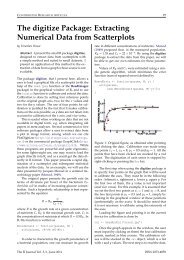prueba
probando yumpu
probando yumpu
You also want an ePaper? Increase the reach of your titles
YUMPU automatically turns print PDFs into web optimized ePapers that Google loves.
20<br />
disease outbreaks (Chretien et al. 2007). Malaria and<br />
other mosquito-borne diseases such as West Nile virus<br />
seem to receive the most frequent attention and be<br />
particularly amenable to modeling efforts involving<br />
spatiotemporal data such as NDVI, due to the close<br />
causal link between rainfall and both mosquito abundance<br />
and NDVI (Brooker et al. 2006, Gemperli et al.<br />
2006, Ceccato et al. 2007, Britch et al. 2008, Brown et<br />
al. 2008). But other zoonoses like Hantaan virus (Yan et<br />
al. 2007), schistosomiasis (Clements et al. 2008, Wang<br />
et al. 2008), Ebola (Pinzon et al. 2004a), bubonic plague<br />
(Kausrud et al. 2007), leishmaniasis (Werneck et al.<br />
2007), Rift Valley fever (Anyamba et al. 2009) and others<br />
have been found to have spatial and/or temporal<br />
components associated with NDVI variability.<br />
4. SCALES OF ENVIRONMENTAL CHANGE AND<br />
ANIMAL MOVEMENT<br />
The availability of data and methods to analyze animal<br />
movement has increased exponentially with the<br />
help of GPS-based technology, allowing the tracking<br />
of animals that cover large distances or are difficult to<br />
observe and follow. However, analyses of coupled data<br />
of animal movement and environmental variables in a<br />
unified framework are still lacking. Movement analyses<br />
of different taxa and species, such as mammals,<br />
birds, insects and amphibians, has largely been developed<br />
independently (Fryxell & Sinclair 1988, Alerstam<br />
et al. 2003, Grayson & Wilbur 2009). Also, movements<br />
at different spatial scales are often explained by different<br />
mechanisms such as migration versus feeding<br />
(Dingle 1996, 2006). The high temporal resolution of<br />
NDVI is particularly helpful in studying animal movements,<br />
since data on vegetation productivity can be<br />
linked to location data of individuals at the same time.<br />
Instead of traditional habitat selection analyses that<br />
use static habitat maps, dynamic landscape models<br />
based on NDVI allow the examination of movement<br />
decisions of individuals or populations as resource<br />
availability changes in time. For example, at broader<br />
scales, shifts in relative NDVI distribution can explain<br />
movement to and from seasonal ranges (e.g. Ito et al.<br />
2006). On finer scales NDVI may be used to trace habitat<br />
choices of single individuals at a particular movement<br />
step (Hebblewhite et al. 2008). Thus, NDVI can<br />
be used to study movement patterns at different spatial<br />
scales in a unified framework (Nathan et al. 2008).<br />
Ryan et al. (2006) found that African buffalo had a<br />
reduced length of short-term ranging distances with<br />
increased values of NDVI, while it had no impact on<br />
estimated range size. The use of NDVI thus uncovered<br />
a behavior at a fine temporal scale that had not previously<br />
been explored. Wittemyer et al. (2009) found that<br />
Clim Res 46: 15–27, 2011<br />
for African elephants, the peak in primary productivity<br />
matched the change from random movements to more<br />
directional movements. This study showed directional<br />
movement in relation to resources (food and water)<br />
during the dry season and more random movements<br />
during the wet season. By monitoring radio-collared<br />
Svalbard reindeer females, Hansen et al. (2009) were<br />
able to demonstrate that changes in forage abundance<br />
(as indexed by NDVI) can strongly influence winter<br />
habitat–space use interactions in predator-free systems,<br />
with females exhibiting more quality-based selection<br />
at the expense of quantity when forage abundance<br />
increased. NDVI was also useful in explaining an unusual<br />
mass aggregation of Mongolian gazelle: Olson et<br />
al. (2009) observed more than 200 000 gazelle that had<br />
all moved to the same region, and subsequently found<br />
that NDVI showed a temporary ‘green up’ of that<br />
particular location that perfectly aligned with the mass<br />
aggregation of gazelle. Importantly, dynamic landscape<br />
models based on NDVI can be used to gain a<br />
more mechanistic understanding of long distance<br />
animal movements: landscape models based on NDVI<br />
were key in explaining the wildebeest migration in the<br />
Serengeti. Boone et al. (2006) demonstrated in individual<br />
based models that NDVI was critical to ‘evolutionarily<br />
train’ model-organisms to reproduce patterns of<br />
wildebeest migration.<br />
5. SPARSELY VEGETATED AREAS<br />
It has been previously acknowledged that the relationship<br />
between NDVI and vegetation can be biased<br />
in low vegetated areas, unless the soil background is<br />
taken into account (Huete 1988). Asrar et al. (1984), for<br />
example, demonstrated that for a LAI below 3, NDVI<br />
was mainly influenced by soil reflectance. Such results<br />
led to a common belief that NDVI could not be used in<br />
semi-arid, arid and desert areas, as well as polar environments—where<br />
vegetation is sparse and growing<br />
season short. Yet several recent studies have shown<br />
that NDVI could provide useful information even in<br />
sparsely vegetated areas: in the Kerguelen archipelago,<br />
Santin-Janin et al. (2009) demonstrated how<br />
NDVI correlates with ground-based measurements of<br />
plant biomass; in north-central Chile, De la Maza et al.<br />
(2009) demonstrated that NDVI could be related to<br />
ground-truthed measures of vegetation productivity,<br />
allowing exploration of the relationship between rainfall<br />
patterns and vegetation cover and productivity<br />
related to El Niño phenomenon. Using NDVI data, it<br />
was possible to determine that rainfall not only influences<br />
plant productivity, but also has a strong effect on<br />
plant phenology, determining the length of the growing<br />
season, which in turn contributed to increased bio-



